I scale up a tower I have never climbed before and survey the land. There are new events in which to participate now, and new adventures to undertake. I leap to the ground below from this dizzying height, landing safely and breaking multiple laws of physics in the process.
I crouch in the bushes and wait for a sword-wielding guard to approach. I surreptitiously assassinate him when he draws in close, then rush towards a nearby lookout. I clamber up the structure until an unsuspecting archer is standing just above me. I plunge my blade into his torso, then watch as his corpse falls victim to the laws of gravity, emitting a thud when it strikes the rocks below.
You'd suppose I am describing the next Assassin's Creed, but the adventure in question is Middle-earth: Shadow of Mordor, a game that invites countless comparisons to Ubisoft's parkour-oriented series. On the surface, Shadow of Mordor is Assassin's Creed set in the Lord of the Rings universe. You ascend tall structures and engage in rhythmic combat against large numbers of swordsmen. You activate a special mode of vision that allows you to identify objects and people of interest. I wouldn't call Shadow of Mordor a rip-off, but its inspirations are clear: Developer Monolith chose a foundation that is instantly familiar to anyone who has met Ezio Auditore or Edward Kenway.
Shadow of Mordor's hero--or heroes, as it were--shares little thematic DNA with Desmond Miles and his kin, however. You are a ranger called Talion--but you are also a bitter wraith who shares Talion's body, the two cursed by unknown forces, each seeking the answers that would allow for peace. For all purposes, Talion should be dead, but his spiritual homecoming has been delayed by this unholy union. Their journey of discovery takes them through Mordor and a nearby region, where the cracked earth and the sight of suffering slaves serve as warning signs; Death here is more common here than the healing herbs that sometimes rise from the decayed soil.
I'll allow the more erudite Middle-earth experts to debate the authenticity of this wraith-ranger hybrid. Talion certainly seems like a good fit for Tolkien's universe, with his stringy shoulder-length hair, his stoic manner, and his three-syllable moniker, which recalls names like Faramir and Aragorn. The wraith's identity has been previously revealed, but I'd prefer not to disclose it here: the murky flashbacks that depict his past deeds are all the more impactful when you've denied yourself the spoiler. In any case, the Talion/wraith dichotomy leads to Shadow of Mordor's slickest moments. The ghostly wraith slides out of Talion's body from time to time to talk with him and then dissipates in a vaporous sigh. When the wraith's anger becomes all-consuming, Talion's face melts away to reveal the apparition underneath. Vague whispers and murmurs bring an eerie chill to an otherwise parched setting; it's as if there is danger of being frozen even in this grim hellscape.
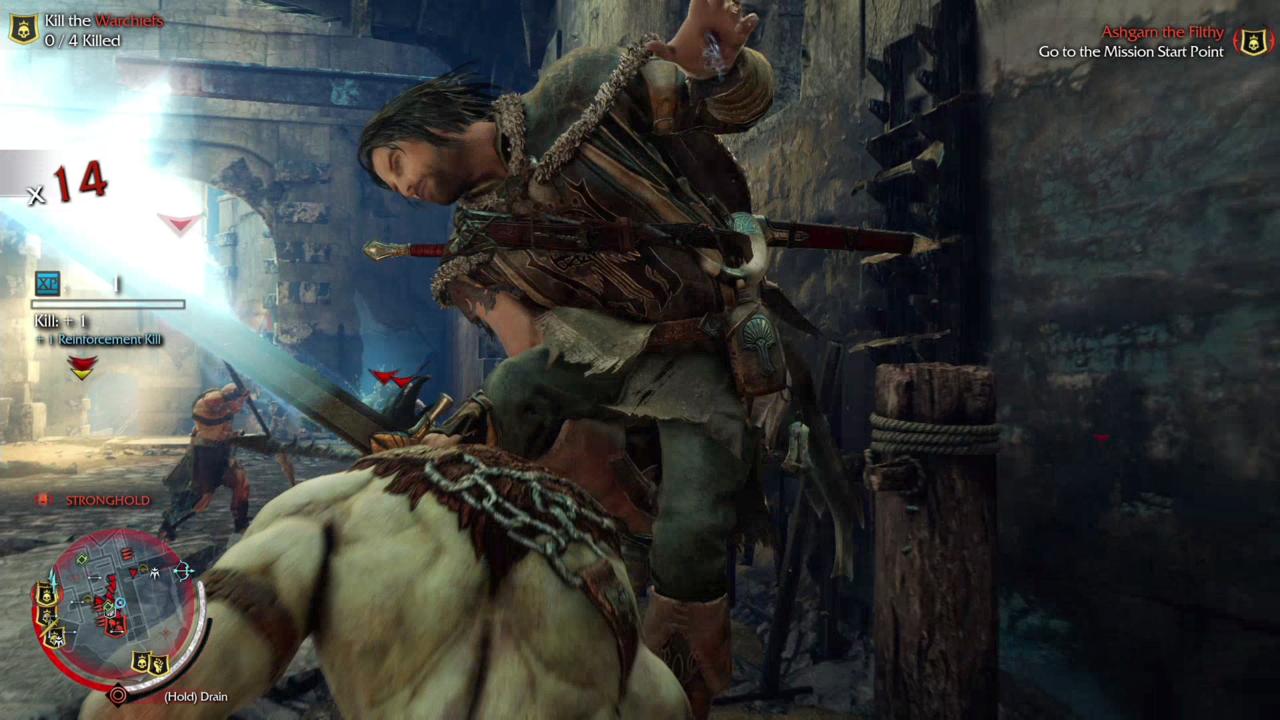
These touches give Shadow of Mordor a gossamer coating it greatly needed. The game's occasionally iffy frame rate doesn't make a strong argument for the power of the new console generation, but the burnt orange-brown cliffs and clouded skies are nonetheless given their proper due. To exist here is to suffer a heavy heart. Your ears are invaded by the growls and grunts of the grotesque Uruk-hai that roam the land, and your eyes are overwhelmed by the crumbling ruins of once-proud buildings. The same-ish landscapes wear thin in time, though a mid-game change of scenery allows you to breathe in air not yet fully spoiled by the evil Sauron's rancid presence. They say that the devil is in the details, but in Mordor, the devil is plain to see. It is in the details that you find the glimmers of light, even though you know that no happy ending is nigh. There is hope in the hearty laugh of a dwarf that becomes your hunting partner, and in the gentle words of a daughter protective of her sorcerous mother.
Had I been more invested in the game's outcome, I might have appreciated those glimmers even more. Shadow of Mordor hits the ground running, referring to the past and future both while crafting its own story within the crevasses left unexplored in book and movie form. Gollum is as disquieting a presence as ever, and actor Liam O'Brien's excellent vocal performance is so on point, you would assume Andy Serkis, who portrayed Gollum on film, had reprised the role here. But for every recognizable character there is a less-established one, and both variations weave in and out of the story with little explanation, kickstarting the plot when necessary and then departing before you can truly come to know them. The game's main villains appear before they're even properly introduced; a Tolkien fanatic may be intrigued by their identities, but Shadow of Mordor does too little to make them anything more than mean guys in fancy armor. The incomplete storytelling, combined with a series of tepid final encounters, unfortunately softens the sting of the conclusion's slashing and gnashing.
Your ears are invaded by the growls and grunts of the grotesque Uruk-hai that roam the land, and your eyes are overwhelmed by the crumbling ruins of once-proud buildings.
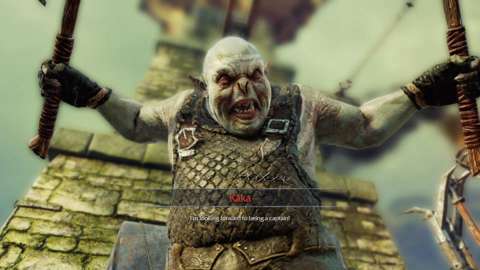
Of course, this is Tolkien, whose novels have always been about the unexpected journey, not the expected destination. Shadow of Mordor is a raucous adventure. You hold a single button to rush up towers and leap improbable distances, and fluid animations make the locomotion feel (usually) breezy and fun. An Uruk archer may be waiting atop that tower, but no matter: another button allows you to stab him from below, though you could always sneak up from behind and sink your hidden blade--er, your totally unhidden dagger--into his stinking flesh, if you'd rather. Yes, it's easy to make the Assassin's Creed connections, particularly when you encounter the frustrations Shadow of Mordor shares with that other series: a lack of precise movement that makes certain simple actions more trouble than they're worth, clumsy camera angles, and animation quirks that turn close-quarters battles into awkward, jittery dances.
Luckily, Shadow of Mordor greatly refines and improves other aspects of that established formula. Combat, for instance, has a similar kind of flow, but it's more challenging than you might be used to. Hordes of Uruk-hai surround you, and your experience with other games might fool you into thinking you can manage the mob. That little voice telling you can handle the challenge could be lying, though. There are times when you must simply run. You might be able to hide in a bush a few hundred feet away, or you might rush to a higher vantage point until the crowd calms down. But to face the Uruk swarm, even when you time your counter-attacks properly, is often to face your own demise and subsequent resurrection.
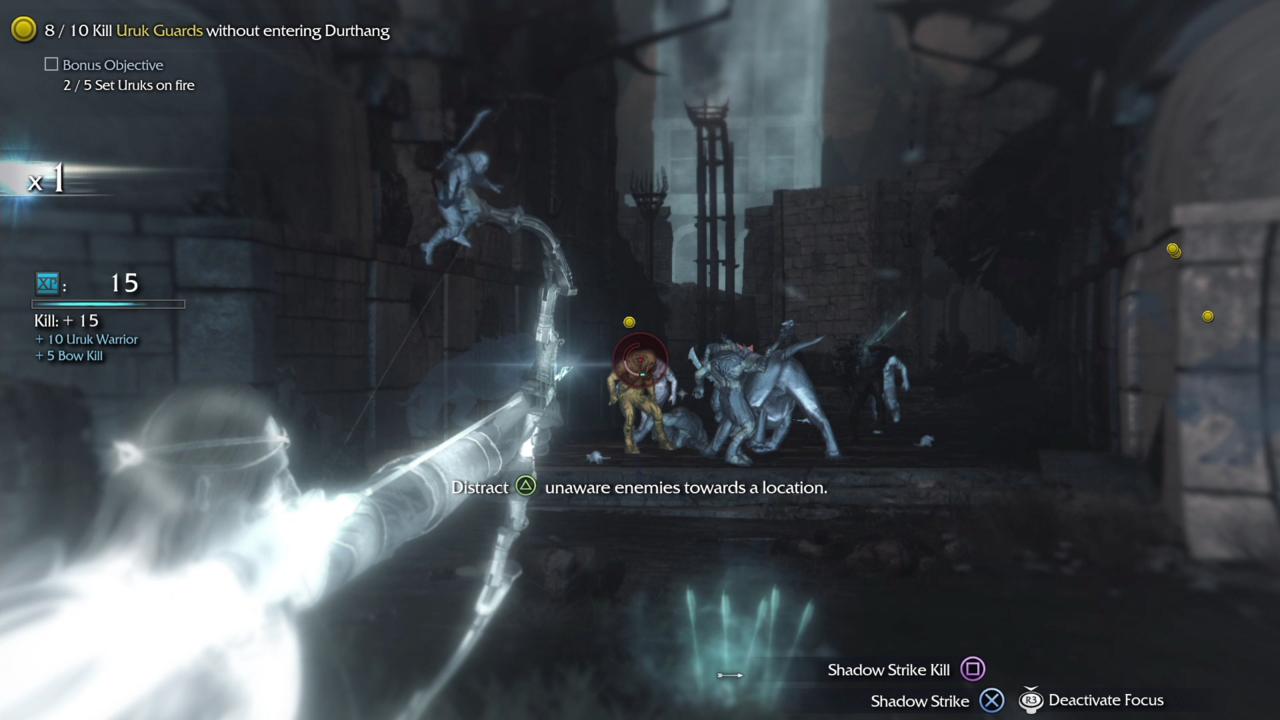
The addition of a real challenge to this recipe has a lot of rewarding repercussions. Stealth becomes a vital tool, for instance, even when the mission at hand doesn't demand it. Orcs can be oddly oblivious when you brutalize the fiends walking directly behind them, but iffy AI aside, sneaking around is both helpful and exciting. Thinning the herd is a wise move, and doing so often means gliding up to your target from behind in a crouched stance that recalls Batman: Arkham Asylum, Shadow of Mordor's other great inspiration. Try murdering Uruk-hai from a perch above, or fire the wraith's spectral arrows into their heads. You'll be glad you did so when you command the attention of an Uruk captain or the region's warchief.
A captain's arrival is a big deal, and Shadow of Mordor ensures you know it. Your sword meets the leader's, the camera zooms in, and the Uruk taunts you with howls and hisses that expose his situational awareness. Upon a first meeting, the Uruk may promise you a grisly dismemberment; should you die and face the same captain again, he will wonder how you cheated death, or ask if you are that other ranger's twin brother. He might remark on the sneaky way you approached him, or declare that he's now on to your combat tricks. The game's database of potential responses must be enormous: I rarely heard the same lines twice, and when I did, I was still amused by the Uruks' grand posturing. Such melodrama! Each captain is so incredibly certain of his own victory that he must bare his fangs and puff his chest up with pride.
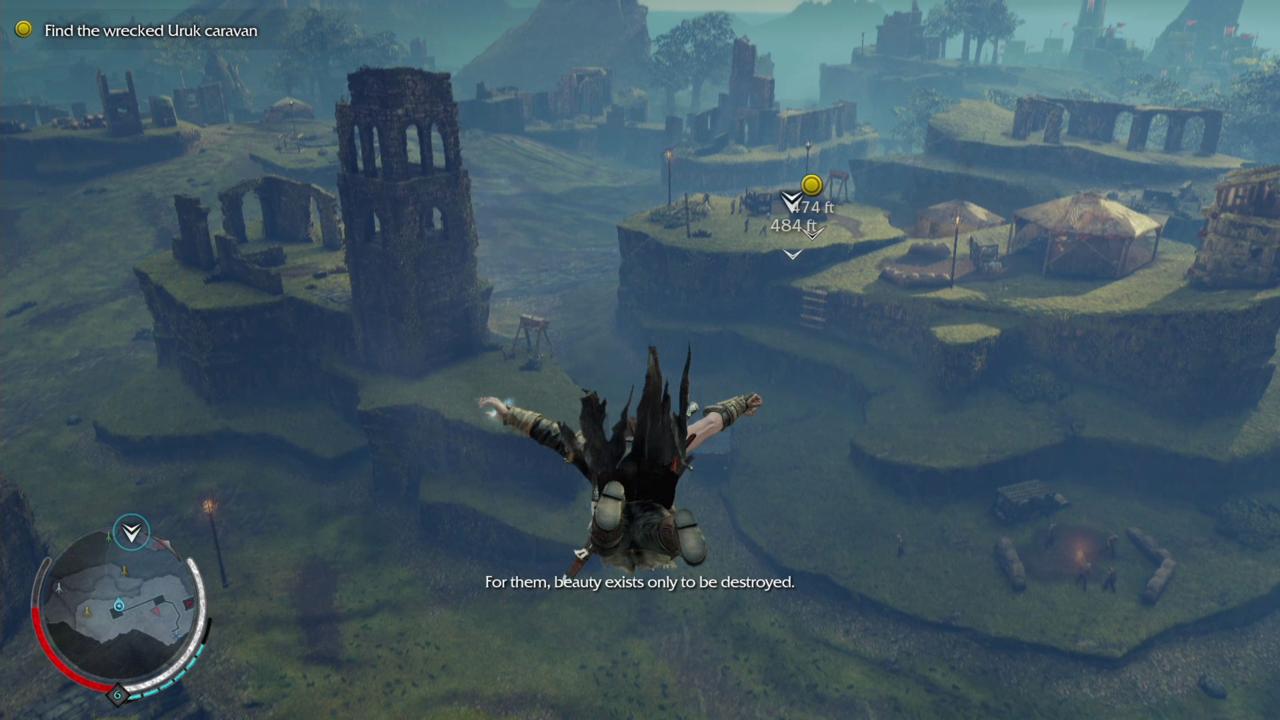
The only problem with making a mountain out of every orcish molehill is one of pacing: after a while, I became annoyed by the incessant theatrical introductions, which would sometimes occur just when nearing my target. It doesn't matter if you're in the midst of battle or just rushing through the area: the Uruk demands your respect, even if it means disrupting the flow and forcing the camera away from its original direction once the hullabaloo is complete. But what to do? Each captain craves his 15 minutes of fame.
Captains aren't impossible to defeat, of course, but you'll be better equipped to defeat them once you add a few additional skills to your repertoire, which you do by performing missions and assassinating enemies. The move I came to most appreciate allowed me to stun an enemy by leaping over his head, then unleash a barrage of strikes that culminated in a cranial explosion. Repeating this move is the closest I came to exploiting the combat system, unless you count my reliance on converting Uruks to my cause, an option that doesn't unlock until the game reaches its second act. In fact, Shadow of Mordor's best asset, the hierarchical machinations it terms the nemesis system, doesn't truly shine until the latter half.
Talion certainly seems like a good fit for Tolkien's universe, with his stringy shoulder-length hair, his stoic manner, and his three-syllable moniker.

You see, a dead Uruk doesn't tell tales, but there's always a mouthy filthmonger ready to replace him. You can view the Uruk-hai's reporting order at a glance, though you don't necessarily know every captain's identity or combat weaknesses: you'll have to gain some intel for that. You most commonly gain intel by dominating your foe rather than outright killing him. Shadow of Mordor's executions are gory indeed, but domination is an even more fearsome process: Talion's flesh fades away and the wraith is revealed in all his ferocity. You roar out a battlecry--even simple shouts like "You are mine!" are pregnant with barely-contained rage--and then violate the Uruk's mind. You then examine the organizational Uruk flowchart, expose a captain's identity and/or combat weaknesses, and then squash your victim's head like an overripe cantaloupe. (Or, later, allow him to go free to spread word of your reign of terror.)
This is useful information to have. Again, overthrowing a captain or warchief is not always a walk in the park, so knowing that your enemy is invulnerable to your phantom arrows, or will succumb to a stealth kill, makes all the difference. You can even instill fear in captains by shooting explosive barrels and catching them on fire, or by riding a caragor into battle. Oh--did I not mention you can mount a four-legged feline beast and command it to feast on Uruk entrails? You can even clamber up walls while riding a caragor. Try that, Altair!
A dead Uruk doesn't tell tales, but there's always a mouthy filthmonger ready to replace him.
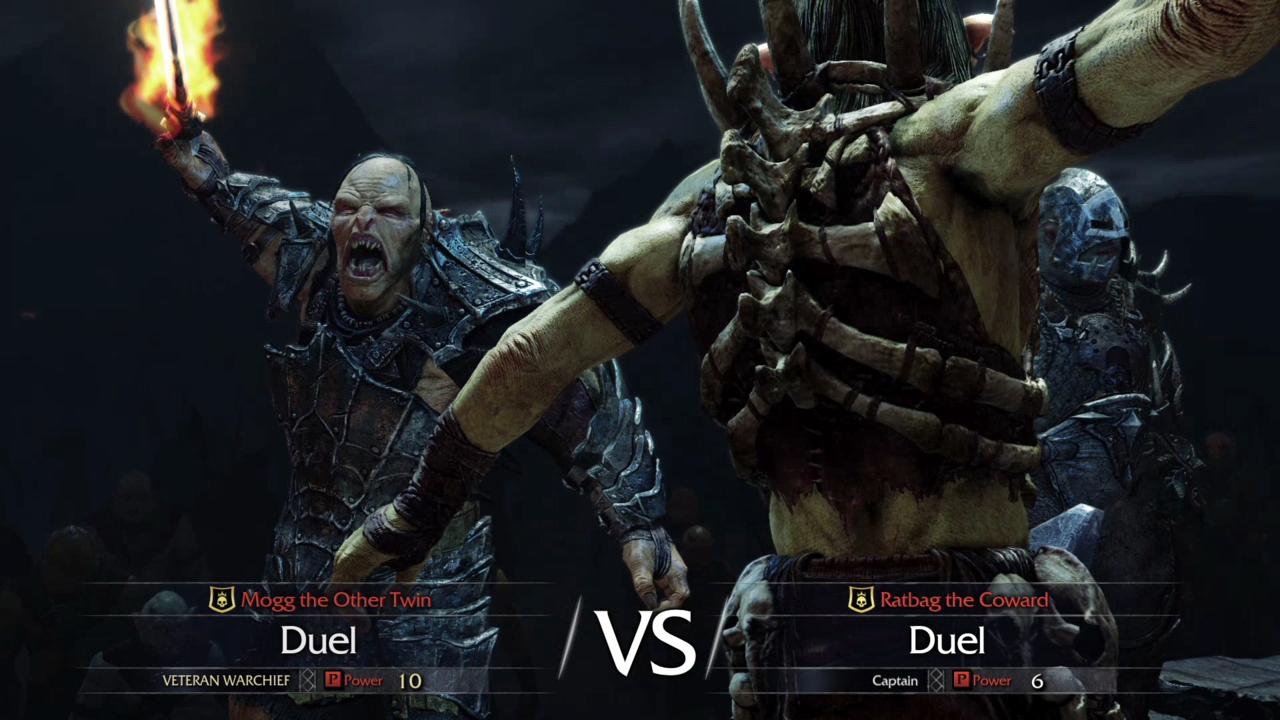
Shadow of Mordor's second half introduces even more ways to mess with Uruks' minds. Ultimately, you are able to command individual captains and assist them in battle as they fight their way up the pecking order. The story gives this system a purpose so that your political shenanigans don't come across as neverending busywork, though even without narrative context, the nemesis system is remarkably absorbing. It is the orcish congress, and I am a muscled version of Kevin Spacey's character in House of Cards. I am the puppetmaster, and the Uruk-hai are my puppets.
All of these tasks are dotted across the game's two expansive maps, which invite you to chase one waypoint after another, murdering captains, infiltrating Uruk feasts, and collecting artifacts that unveil truths about the wraith's past misdeeds. This structure (of course) recalls Assassin's Creed, but it is now imperative that the Assassin's Creed series learn from Shadow of Mordor. Easy comparisons aside, this is a great game in its own right, narratively disjointed but mechanically sound, made up of excellent parts pieced together in excellent ways. I already knew what future lay in store for Middle-earth as I played Shadow of Mordor; I'm hoping that my own future might one day bring another Lord of the Rings adventure as stirring as this one.